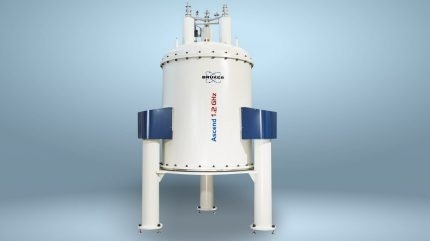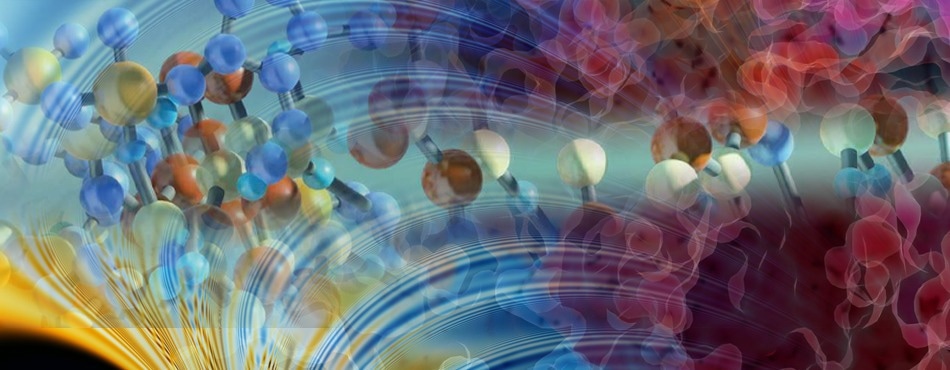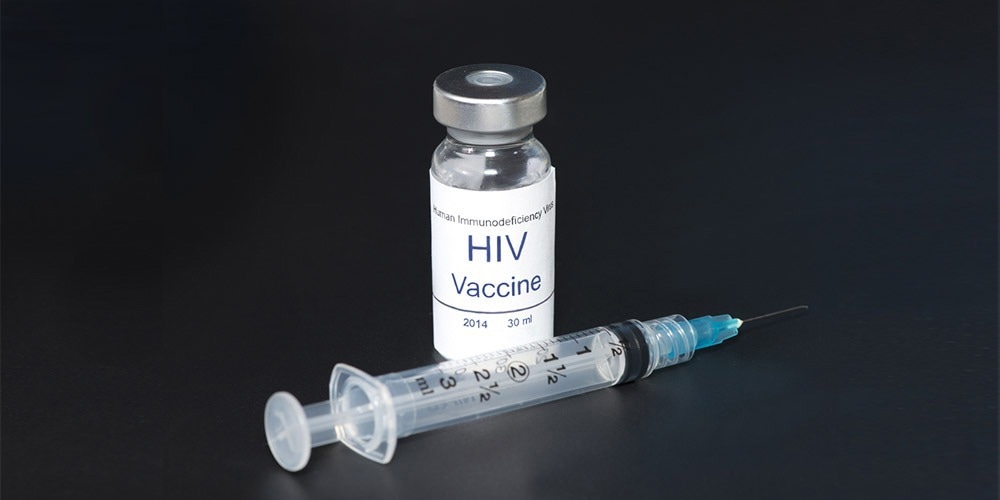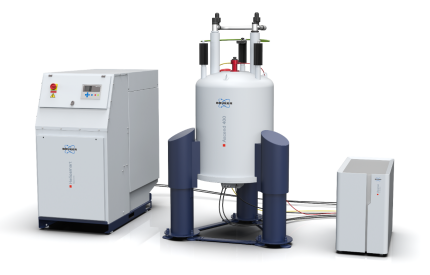For several decades, Bruker has focused on the design and manufacturing of magnets and cryogenic systems, growing to become the largest producer of superconducting magnets for nuclear magnetic resonance (NMR) worldwide.
Bruker's Ascend line of magnets combines several of Bruker’s proprietary, innovative magnet technologies for best performance and cost efficiency.
Highlights
300 MHz – 1.2 GHz
The Ascend line of superconducting magnets ranges from 300 MHz up to the world-record-breaking 1.2 GHz.
Easy siting
With cutting-edge superconductor technology, the Ascend magnet design can create smaller magnet coils, significantly reducing the magnet’s physical size and weight.
Stability and shielding
In addition to the External Disturbance Suppression (EDS), which offers up to 99% screening efficiency against external magnetic field disturbances, unique jointing technology produces the lowest drift rates for exceptional field stability.
Features
Incorporating key technologies for best performance and cost efficiency
The Ascend™ series of compact NMR magnets makes medium and high-field NMR spectroscopy extremely powerful and, at the same time, convenient and reliable. Ascend magnets integrate various magnet technologies from Bruker, resulting in exceptional performance and operational cost efficiencies.
The Ascend magnet design features advanced superconductor technology, enabling the design of smaller magnet coils, thus significantly reducing physical size and magnetic stray fields. The Ascend magnets are, therefore, easy to site, convenient, and cost-efficient to operate.

Image Credit: Bruker BioSpin - NMR, EPR and Imaging
Maximum performance
- Advanced shimming technology for highest field homogeneity
- Available with high-performance vibration isolators
- Cryostats with excellent thermal efficiency for low cryogen consumption
- External Disturbance Suppression (EDS) with up to 99% screening efficiency against external magnetic field disturbances
- Unique jointing technology leading to the lowest drift rates for outstanding field stability
Minimum stray fields
- Easy siting with less preparation costs
- Reduced ceiling height requirements
- Easy magnet access and rigging due to smaller weight and size
- Reduced physical and magnetic footprint in the lab
Ascend magnets are designed to work best with Bruker’s refrigeration equipment, automation technologies, room temperature shim systems, and NMR probes. These applications include integrated high-performance NMR systems for materials research, small molecule, and/or structural biology applications.
Ascend magnets from Bruker are also available in two diameter sizes: standard-bore, which measures 54 mm, and wide-bore, which measures 89 mm.
New Ascend Evo 1.0 GHz NMR Magnet
Novel single-story compact NMR with reduced helium consumption
With its unique compact magnet, the Ascend Evo 1.0 GHz NMR system drastically lowers its footprint, weight, and ceiling height requirements while also offering a dramatic three-fold reduction in liquid helium consumption.
Thanks to this innovative and distinctive design, more labs will be able to use it, which also drastically lowers siting, installation, and operating costs.

Image Credit: Bruker BioSpin - NMR, EPR and Imaging
Benefits
Current state-of-the-art superconducting wire technology allows for 1.2 GHz magnetic field attainment. In addition, advanced superconductors make the design of extremely compact NMR magnets possible. This, along with active shielding's ability to minimize stray fields, is a major advantage when placing NMR systems in laboratories with limited space.
When an NMR spectrometer must be placed in a difficult environment, Bruker's Electromagnetic Disturbance Suppression (EDS) offers superior screening efficiency against external magnetic field disturbances. Bruker's exclusive jointing technology guarantees the lowest drift rates for high-current and high-field joints.

Image Credit: Bruker BioSpin - NMR, EPR and Imaging
Operational cost savings
Source: Bruker BioSpin - NMR, EPR and Imaging
| Standard Bore Ascend Magnet |
Typical Helium Consumption |
| 400 MHz |
13 ml/h |
| 500 MHz |
13 ml/h |
| 600 MHz |
16 ml/h |
| 700 MHz |
26 ml/h |
| 800 MHz |
47 ml/h |
| 1.0 GHz |
< 80 ml/h |
| 1.2 GHz |
< 250 ml/h |
Applications
Novel methodology for labeling pancreatic islets before transplantation
Using a Bruker Avance III 400 MHz spectrometer, nuclear magnetic resonance imaging was used to evaluate the labeling process and compare it to passive endocytosis. The transplanted pancreatic islets were imaged using a 4.7 T Bruker BioSpin imager.

Image Credit: Bruker BioSpin - NMR, EPR and Imaging
Characterizing new oncology drugs with NMR
Utilizing NMR spectroscopy, recent research has pinpointed structural alterations to baicalein that yield notable anti-angiogenic and anticancer properties, devoid of associated toxicity.
Specifically, compound 42, with a piperazine acetamide group added at position 6, emerged as a promising novel candidate warranting further assessment for its potential as a cancer therapy.

Image Credit: Bruker BioSpin - NMR, EPR and Imaging
NMR 101
Nuclear magnetic resonance (NMR) spectroscopy is a powerful non-destructive analytical technique that provides a wealth of information about the structure, identity, concentration, and behavior of molecules in solid or liquid samples. It does this by using the intrinsic magnetic properties of particular atomic nuclei.

Image Credit: Bruker BioSpin - NMR, EPR and Imaging
Using NMR to assess anti-malarial efficacy
Malaria is a deadly infectious disease that claims the lives of about 500,000 people on an annual basis. The unicellular protozoan P. falciparum is the parasite that causes over half of all human cases of malaria.
Once this parasite gets inside a red blood cell (RBC), it goes through a 48-hour developmental cycle. This ultimately leads to the RBC disintegrating and releasing new parasites. The offspring of the protozoa, known as merozoites, can invade a new RBC right away.

Image Credit: Bruker BioSpin - NMR, EPR and Imaging
HIV vaccine target found to be Alpha-Helical by NMR
In a recent study, the 3D structure of a peptide known to be targeted by antibodies produced by HIV vaccination was ascertained using nuclear magnetic resonance (NMR) spectroscopy. The authors describe a dynamic alpha-helical structure that might be responsible for the HIV vaccine’s protective effects.

Image Credit: Bruker BioSpin - NMR, EPR and Imaging
Structural analysis of heparin using NMR spectroscopy and chemometrics
The medication most frequently used to provide anticoagulant and antithrombotic efficacy is heparin, a naturally occurring anticoagulant. When blood thinning is desired, it is used to treat a variety of cardiovascular conditions as well as intravascular coagulation disorders.

Image Credit: Bruker BioSpin - NMR, EPR and Imaging
Accessories
HelioSmart recovery solution
The Bruker HelioSmart Recovery system is a helium collection device that is highly portable and has been meticulously tailored for use with NMR spectrometers.
Helium is an extremely rare non-renewable resource. The Bruker HelioSmart Recovery system collects helium boil-off from NMR magnets and stores the gas in high-pressure cylinders to protect this resource in a socially responsible way and to make lab operations more sustainable.
The gaseous helium can then either be returned to a gas supplier or used again for another purpose. NMR users with access to a helium liquefaction facility can purify and reliquefy the helium and re-use it in an NMR magnet to become more independent, especially during periods of global helium shortage.
To minimize expenses and simplify siting requirements, the Bruker HelioSmart is designed to simultaneously capture the steady-state boil-off from multiple NMR magnets without the need for helium transfers. This approach typically achieves a recovery rate of 80 to 85 percent.
The Bruker HelioSmart Recovery system has been carefully engineered to guarantee safe operation with NMR magnets and has been optimized to eliminate spectral artifacts.
The HelioSmart Recovery is currently only available in selected countries.

The Bruker HelioSmart Recovery is a fully integrated helium recovery system with an internal gas bag and a high-pressure compressor. The compressor starts and stops automatically as a function of the fill level of the gas bag. The recovery system is equipped with an electronic control unit with an intuitive user interface. Image Credit: Bruker BioSpin - NMR, EPR and Imaging